12 Best Workflow Automation Tools for Productivity in 2025
In today's competitive business environment, manual, repetitive tasks are a significant drain on productivity and a major source of errors, especially in regulated fields like legal and healthcare. The constant switching between apps, copying data, and sending routine notifications consumes valuable hours that could be dedicated to strategic, high-impact work. This operational friction is precisely the problem that workflow automation tools are designed to solve. They act as the digital glue connecting your various software applications, allowing them to communicate and execute tasks automatically based on predefined triggers and rules.
By streamlining everything from client intake and document generation to patient data management and compliance checks, these platforms do more than just save time. They enhance accuracy, enforce procedural consistency, and free up skilled professionals to focus on what truly matters: client outcomes and patient care. To further understand the transformative impact of these tools, you can also explore key workflow automation benefits and see how they apply to your specific industry.
Choosing the right platform, however, can be a complex decision. The market is filled with options, ranging from simple no-code connectors to powerful, enterprise-grade integration platforms (iPaaS). This comprehensive guide cuts through the noise. We will provide a detailed comparison of the best workflow automation tools, including Whisperit, Zapier, and Microsoft Power Automate, to help you make an informed decision. Each review includes a practical analysis of features, ideal use cases, screenshots, and direct links, ensuring you find the perfect solution to revolutionize your team's productivity and security posture.
1. Whisperit
Whisperit stands out as a premier workflow automation tool, specifically engineered for professionals in document-heavy sectors like legal, healthcare, and compliance. It leverages state-of-the-art AI to transform document creation through advanced dictation, transcription, and text editing. This platform is not just about converting speech to text; it's a comprehensive system designed to fundamentally streamline and accelerate paperwork, enabling users to complete tasks up to twice as fast.
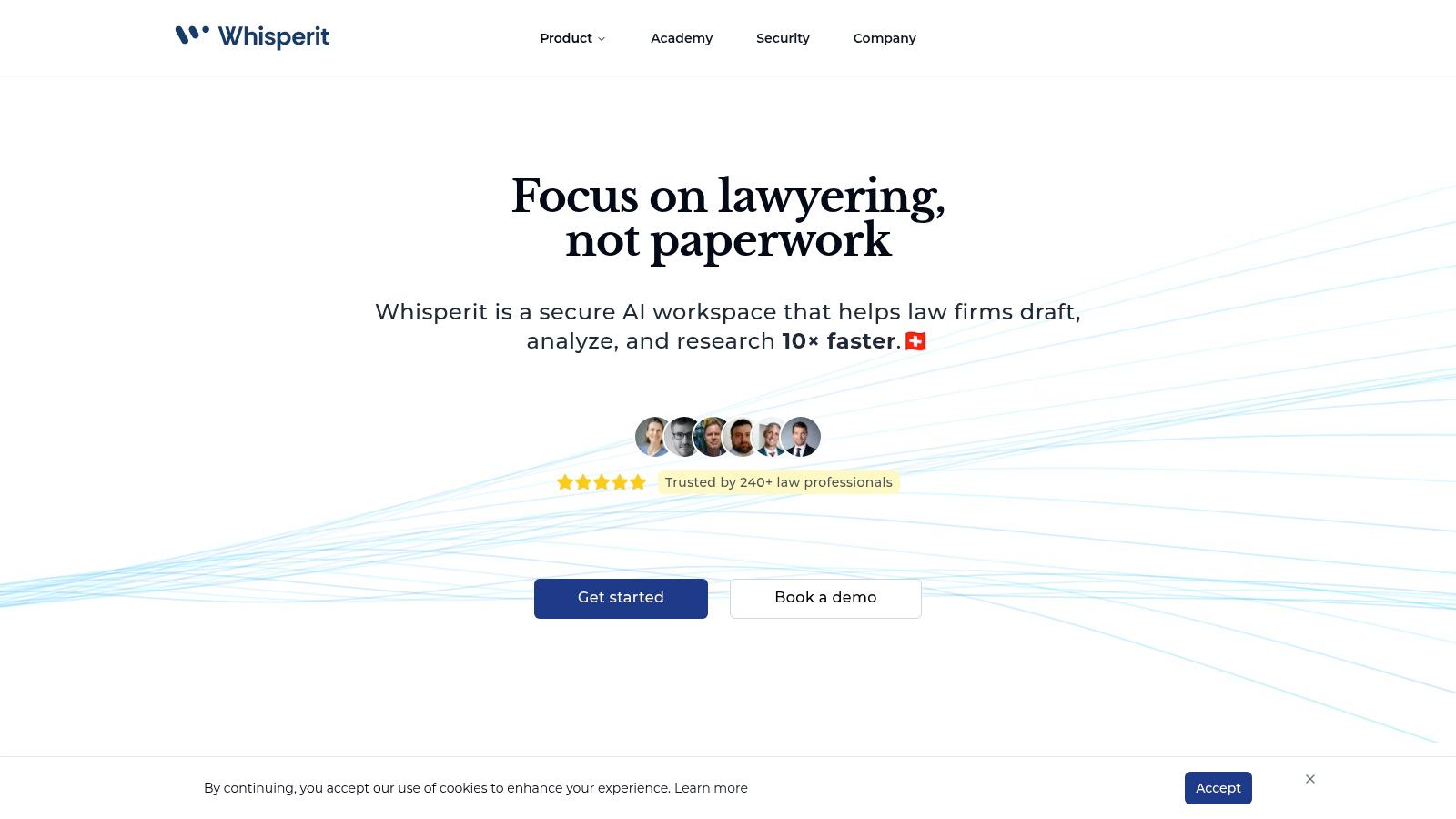
Trusted by over 100 experts, Whisperit integrates seamlessly into existing professional workflows. Its power lies in its ability to understand and adapt to specialized terminology, making it an indispensable asset for creating complex legal briefs, detailed patient notes, or intricate compliance reports with remarkable accuracy and speed.
Key Strengths & Use Cases
Whisperit's primary advantage is its unwavering focus on security and efficiency, making it one of the best workflow automation tools for regulated industries.
- Uncompromising Security: With Swiss-based hosting, end-to-end encryption, and full GDPR and SOC 2 compliance, Whisperit provides a fortress for sensitive client and patient data. This commitment to privacy is non-negotiable for its target audience.
- Intelligent Document Handling: Users can import existing documents and utilize customizable templates, allowing the AI to learn specific formatting and phrasing. This significantly reduces the manual effort required in drafting and editing, freeing up valuable professional time.
- Industry-Specific Application: A lawyer can dictate complex case notes directly into a pre-formatted legal template, while a doctor can transcribe patient encounters with high accuracy. For a deeper look into its sector-specific impact, you can learn more about workflow automation in healthcare on Whisperit's blog.
Considerations
The platform's pricing is not publicly listed, requiring direct engagement with their team for a quote. While its specialization in legal, healthcare, and compliance is a major strength, businesses outside these verticals may find its feature set less universally applicable compared to more generalized automation tools.
Website: https://whisperit.ai
2. Zapier
Often considered the entry point into automation for many businesses, Zapier has established itself as one of the best workflow automation tools by connecting a staggering number of applications. Its core strength lies in its user-friendly interface that allows users to create automated workflows, or "Zaps," without writing a single line of code. This makes it an ideal choice for teams in legal and healthcare who need to connect disparate systems quickly.
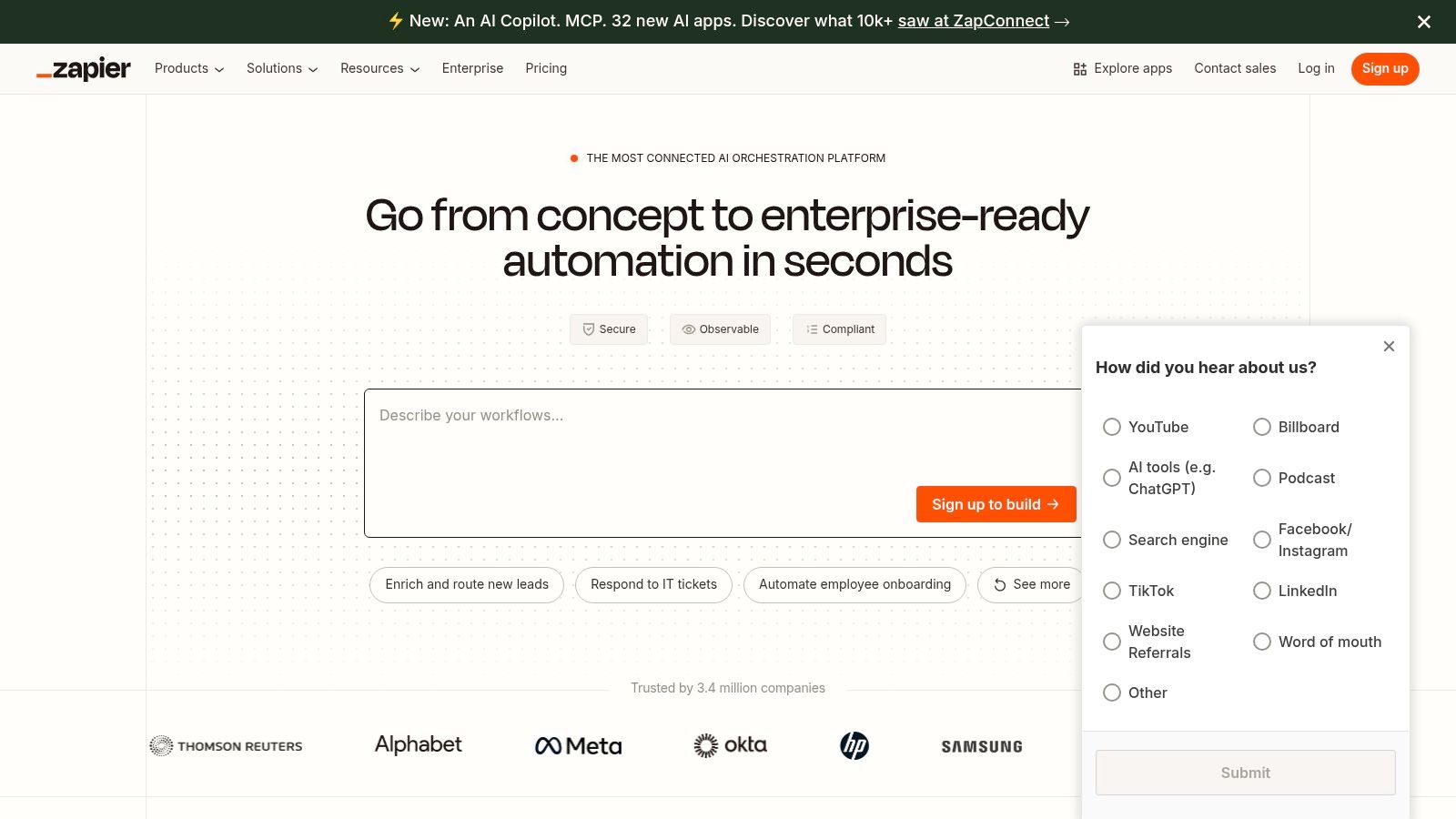
Zapier’s immense library of over 7,000 app integrations is its key differentiator, ensuring that almost any SaaS tool a professional services firm uses can be connected. For instance, a law firm can automatically create a client folder in a secure document management system whenever a new client is added to their CRM. Similarly, a healthcare provider can trigger notifications to administrative staff when a patient form is submitted through a HIPAA-compliant web form.
Core Features & Use Case
- Massive Integration Directory: Connects to over 7,000 apps, including specialized software used in legal tech and healthcare IT.
- AI-Powered Tools: New features like Zapier Agents and Chatbots (in beta) allow for more complex, multi-step tasks to be handled autonomously based on natural language commands.
- Interfaces & Tables: Build simple, no-code applications, forms, and databases directly within Zapier to manage data or create internal tools without needing a separate platform.
Pricing and Access
Zapier offers a free-forever plan with limitations on tasks and multi-step Zaps, which is excellent for testing. Paid plans start at the Team tier (around $69/month) and scale up to the Company tier for enterprise needs. It's important to note that access to "Premium" apps and advanced logic requires a paid subscription. The task-based billing can become costly at high volumes, so careful monitoring of usage is recommended for budget predictability.
Website: https://zapier.com
3. Make (formerly Integromat)
For those who find simpler tools too restrictive, Make (formerly Integromat) stands out as one of the best workflow automation tools for its powerful, visual-first approach. It allows users to build intricate, multi-step "scenarios" with a drag-and-drop interface that feels more like a flowchart. This modular design provides granular control over data flow, making it a favorite among power users who need to orchestrate complex processes with conditional logic and error handling.
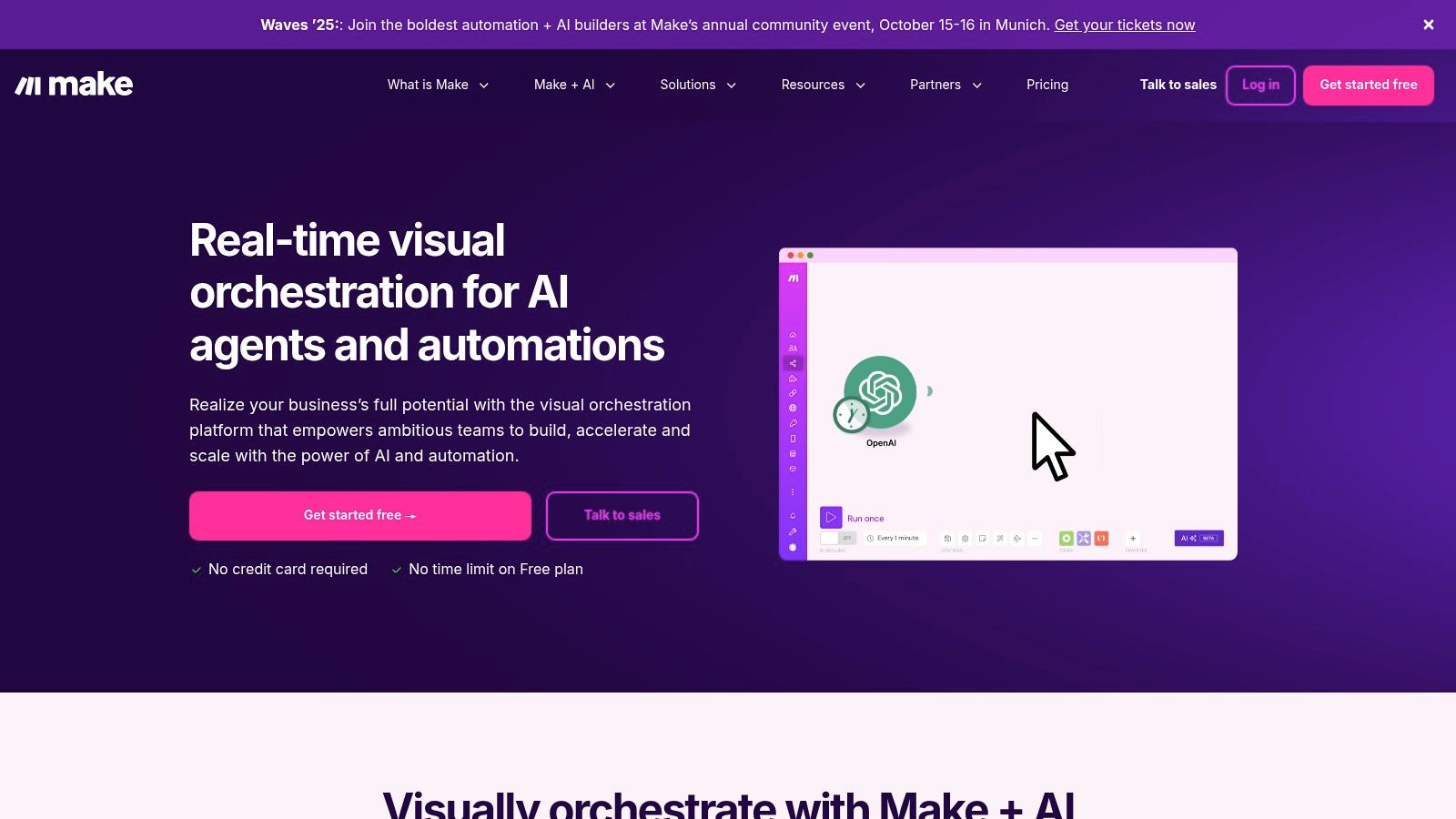
Make's key differentiator is its visual representation of workflows, which clearly shows how data is transformed, filtered, and routed between its 2,000+ app integrations. A healthcare clinic could use Make to parse detailed patient intake forms, route specific data to an EHR system, and send a customized confirmation message, all while handling potential data errors gracefully. For a deeper understanding of its visual approach, you can learn more about how to create workflows on whisperit.ai. The platform's real-time execution log is also invaluable for debugging complex automations.
Core Features & Use Case
- Visual Workflow Builder: Design complex automations with branching logic, routers, iterators, and aggregators for fine-tuned control.
- Granular Data Handling: Built-in tools allow for transforming, mapping, and validating data as it moves between applications.
- Advanced Scheduling & Error Handling: Execute scenarios on a schedule down to one-minute intervals (on paid plans) and create custom error-handling paths.
- Team Roles & Security: Higher-tier plans provide user roles, permissions, and security features suitable for professional services firms.
Pricing and Access
Make offers a generous free-forever plan that includes access to all apps, making it excellent for prototyping. Paid plans begin with the Core tier (around $9/month) and scale up to Teams and Enterprise options. Pricing is based on "operations" (credits), which can be confusing initially but offers transparent, consumption-based billing. The visual complexity can present a steeper learning curve than simpler tools, but the payoff is significantly more powerful automation.
Website: https://www.make.com
4. Microsoft Power Automate
For organizations deeply embedded within the Microsoft ecosystem, Microsoft Power Automate stands out as one of the best workflow automation tools available. Its primary advantage is its native, seamless integration with Microsoft 365, Dynamics 365, SharePoint, and the broader Power Platform. This deep-seated connection allows for robust, secure automation of internal business processes, making it a powerful choice for professional services firms that rely on Microsoft's suite for daily operations.
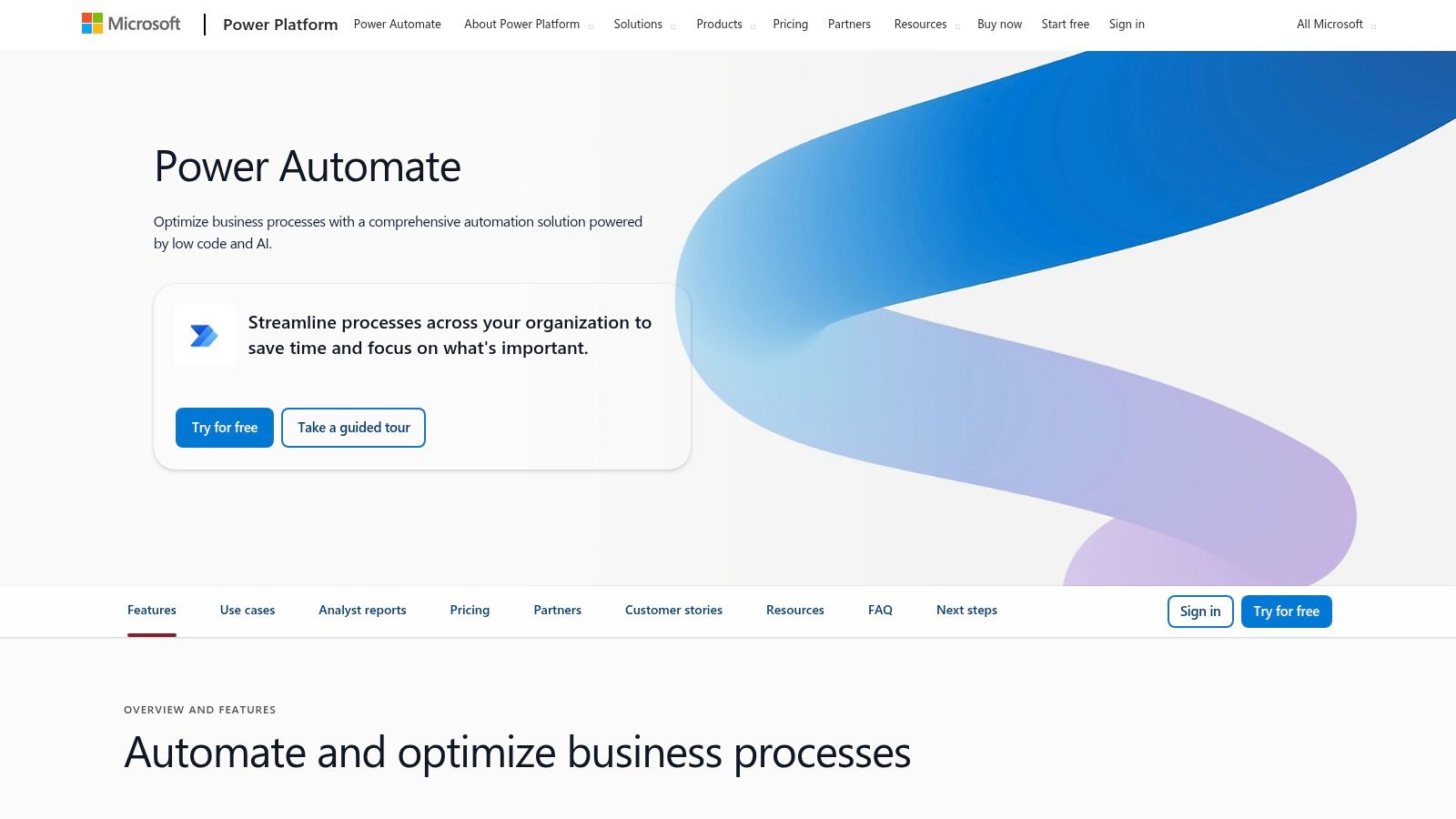
Power Automate excels at both digital process automation (DPA) through cloud flows and robotic process automation (RPA) with desktop flows. For example, a legal firm can create a flow that automatically archives client communications from Outlook into a specific SharePoint folder. A healthcare provider can use desktop flows to automate data entry from legacy systems into a modern EMR, all while operating within Microsoft’s enterprise-grade security and compliance framework.
Core Features & Use Case
- Deep Microsoft 365 Integration: Triggers and actions are built directly into applications like Teams, SharePoint, and Outlook, enabling powerful contextual automations.
- Desktop Flows (RPA): Offers both attended and unattended RPA to automate tasks on legacy desktop applications that lack APIs, bridging the gap between old and new systems.
- Process Mining & AI Builder: Provides tools to analyze existing business processes to identify automation opportunities and embed AI capabilities like document processing directly into workflows.
Pricing and Access
Power Automate’s licensing can be complex. It is often included in certain Microsoft 365 and Dynamics 365 licenses. Standalone plans include a per-user plan (around $15/month) for unlimited flows and a per-flow plan that allows for broader sharing. A pay-as-you-go option is also available for variable workloads. The best value is realized when a business is already heavily invested in the Microsoft ecosystem, as leveraging existing licenses is the most cost-effective approach.
Website: https://www.microsoft.com/en-us/power-platform/products/power-automate
5. n8n
Positioned as a powerful open-source alternative, n8n is one of the best workflow automation tools for technical teams seeking greater control and flexibility. Its "fair-code" model allows users to self-host the platform for maximum privacy and cost-efficiency or use its managed cloud service. This makes it a compelling choice for healthcare and legal firms with strict data residency and security requirements, as workflows can be executed within their own infrastructure.
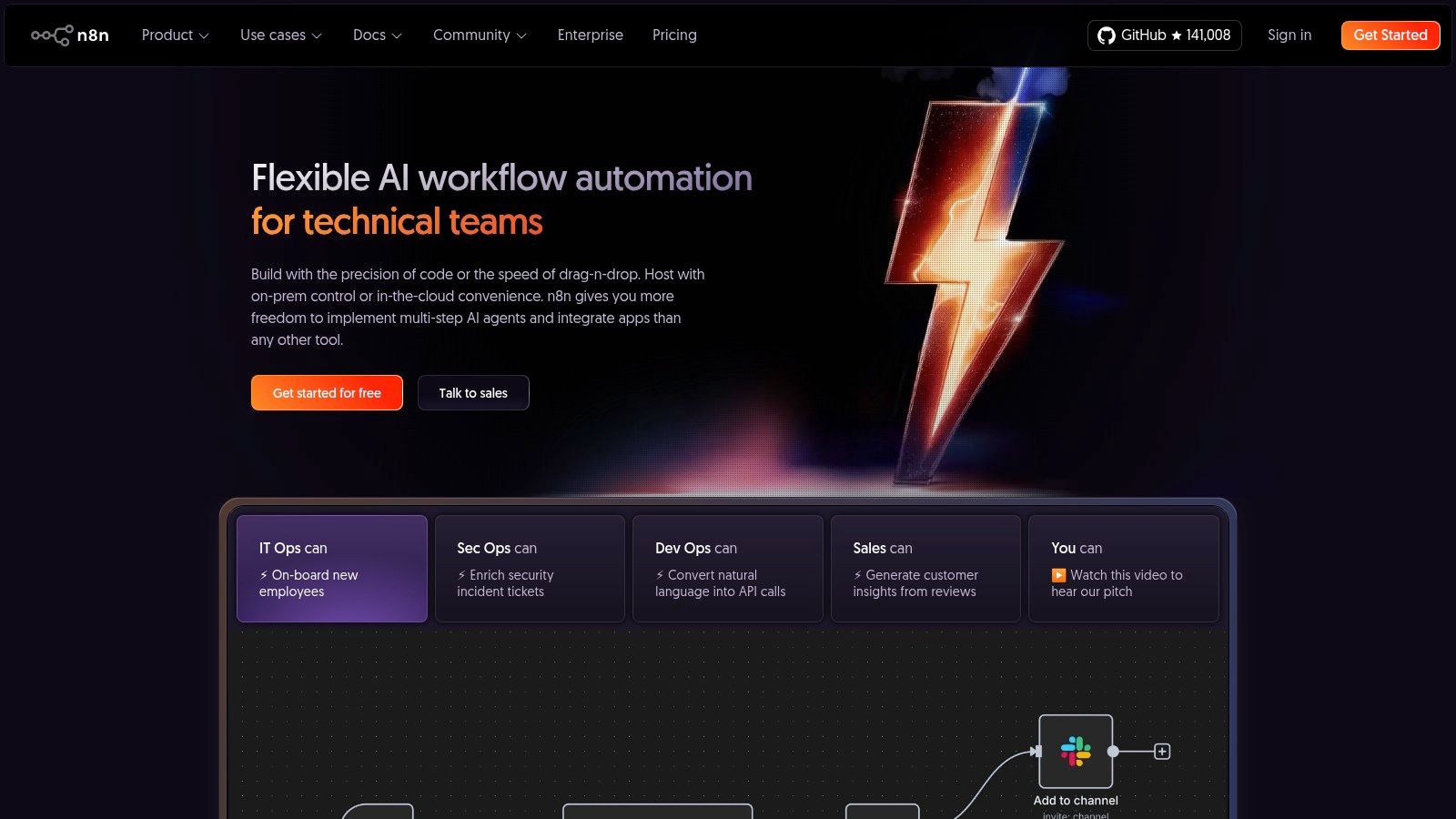
The platform's visual, node-based editor is intuitive for developers but may present a steeper learning curve than pure no-code tools for non-technical users. Where n8n truly shines is its extensibility. If a pre-built integration (or "node") doesn't exist, a developer can easily create custom nodes or use the HTTP Request node to connect to virtually any API, offering near-limitless automation possibilities.
Core Features & Use Case
- Self-Hosting & Extensibility: Offers a free, self-hosted Community Edition for complete data control and the ability to build custom nodes.
- Node-Based Visual Editor: Provides a clear, visual canvas for building complex, multi-step workflows with advanced logic, branching, and error handling.
- Developer-Friendly Environment: Includes features like version control, enabling teams to manage and roll back workflow changes efficiently.
- Transparent Usage-Based Billing: The cloud version bills based on the number of workflow executions, not individual tasks or steps, which can be more cost-effective for complex automations.
Pricing and Access
The self-hosted Community Edition is free. For the managed cloud service, a free Starter plan is available for development and small projects. Paid plans begin with the Pro tier (around $100/month for 10,000 executions) and scale to custom Enterprise plans that include SSO and dedicated support. The primary cost consideration is technical resources if opting for the self-hosted route.
Website: https://n8n.io
6. Workato
Positioned as an enterprise-grade integration and automation platform (iPaaS), Workato is designed for organizations that require robust governance, security, and scalability. It excels at handling complex, cross-departmental processes that go beyond simple task automation. For professional services firms dealing with sensitive data, Workato provides the advanced controls necessary to manage automations securely across the entire business, from finance to HR and client services.
Workato’s key differentiator is its ability to connect cloud applications with on-premise systems using secure agents, a critical feature for established legal and healthcare organizations with legacy infrastructure. This enterprise focus means the platform is built for reliability and high-volume processing. For instance, a healthcare network can use Workato to sync patient data between a cloud-based EMR and an on-premise billing system while maintaining strict compliance and audit trails. Learn more about how to automate administrative tasks to see how such integrations streamline operations.
Core Features & Use Case
- Enterprise-Grade Security: Offers role-based access control, advanced data governance, and compliance features essential for regulated industries.
- Hybrid Integration: Connects thousands of cloud apps and provides agents for secure integration with on-premise databases and applications.
- Workato Academy: Provides extensive training and certification resources to help teams build a dedicated Center of Excellence for automation.
Pricing and Access
Workato’s pricing is quote-based and tailored to specific business needs, reflecting its enterprise focus. It typically operates on a usage-based model tied to the volume of "recipes" (workflows) and tasks. While more expensive than entry-level tools, the cost is justified by its advanced capabilities and governance. This model is best suited for larger organizations or those with a dedicated IT or automation team that can maximize the platform's potential.
Website: https://www.workato.com
7. IFTTT
IFTTT, which stands for "If This Then That," offers one of the most accessible entry points into automation, particularly for individuals and small businesses. Its strength lies in its simplicity, using "Applets" to connect services with a straightforward trigger-and-action model. While not as robust as enterprise-focused platforms, it excels at connecting web services, social media accounts, and Internet of Things (IoT) devices, making it a unique tool for simple, everyday tasks.
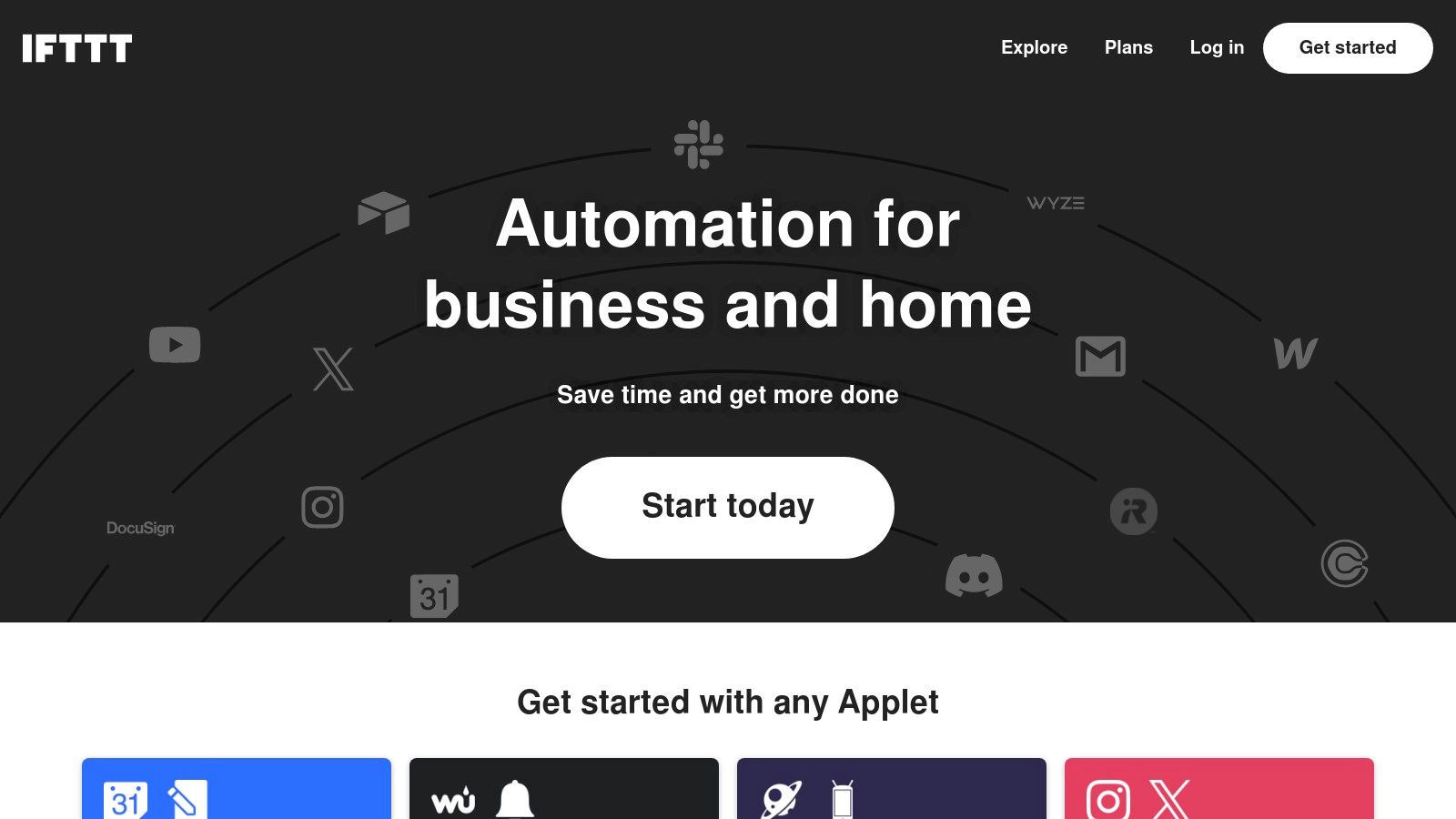
For professional services, IFTTT can handle basic, non-critical tasks like cross-posting firm news to multiple social media platforms or creating a calendar event from a starred email. Its massive library of community-created Applets means many common automations are ready to use with just a few clicks. This simplicity, combined with its mobile apps, makes it an effective tool for managing personal productivity and smart office devices, contributing to improving workflow efficiency on a smaller scale.
Core Features & Use Case
- Simple Applet Builder: Connects two services with a clear "if this, then that" logic that requires no technical expertise.
- Extensive IoT & Consumer App Support: Integrates with a vast number of smart home devices and consumer-facing applications that other platforms may not support.
- Multi-Action Applets: Pro plans allow for more complex Applets that can perform multiple actions from a single trigger, increasing its utility for more involved tasks.
Pricing and Access
IFTTT offers a free plan that allows users to create a limited number of their own Applets. The paid Pro plan (around $2.50/month) unlocks multi-step Applets and faster execution speeds. The Pro+ tier (around $5/month) adds developer tools and advanced features like webhooks for more technical users. Its low cost makes it an excellent choice for basic automation needs, but firms requiring complex business logic or advanced security controls will find its capabilities limited.
Website: https://ifttt.com
8. Tray.io
Tray.io positions itself as a low-code, enterprise-grade automation platform designed for handling complex, high-volume integrations. It excels where simpler tools fall short, offering robust connectivity for RevOps, marketing, and IT teams that need to orchestrate sophisticated, event-driven workflows across their entire tech stack. The platform empowers technical users to build and manage automations that are critical for business operations.
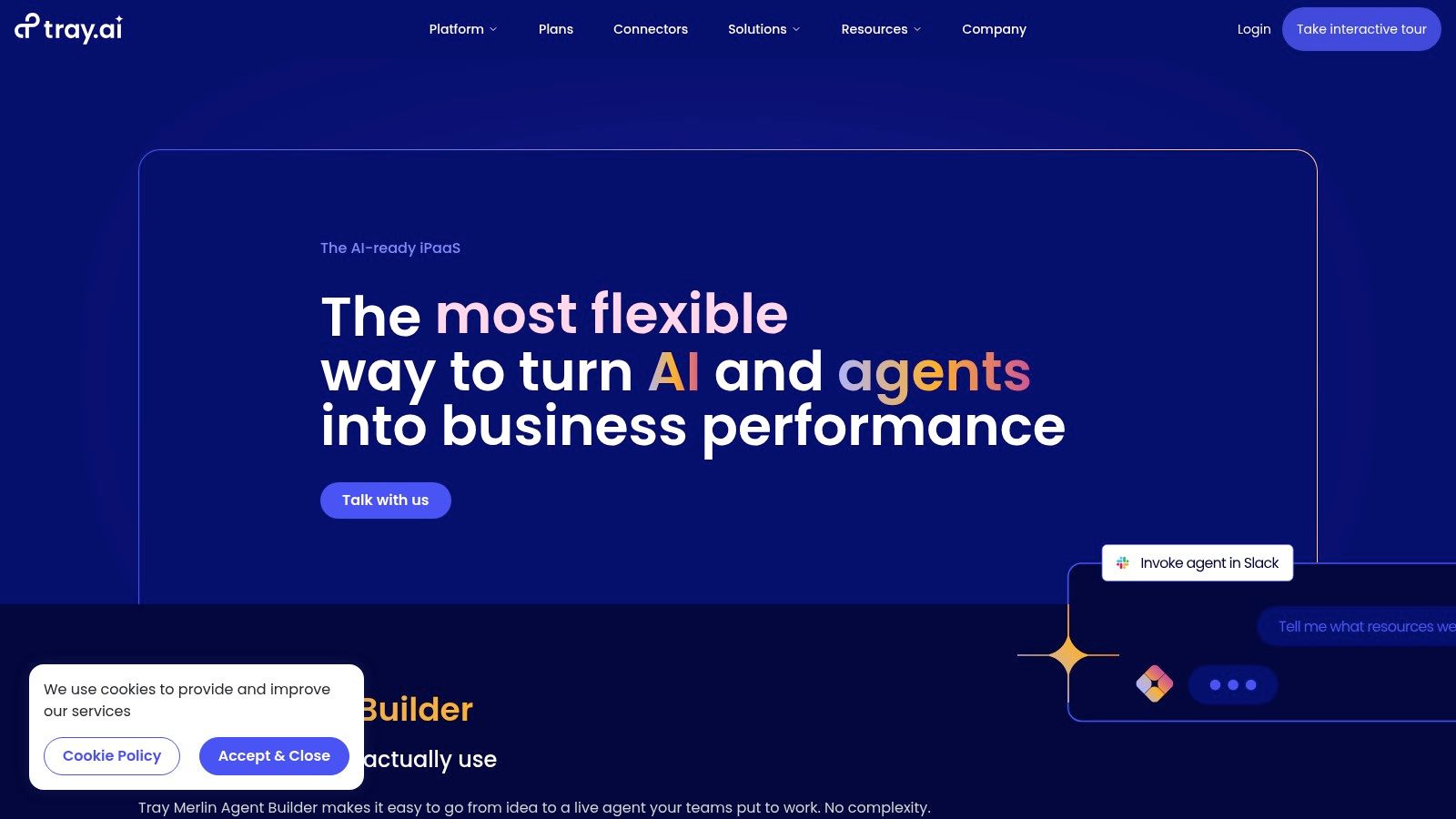
What sets Tray.io apart is its focus on API-first connectivity and enterprise-level governance. For professional services firms dealing with sensitive data, this means greater control over how information flows between systems. For example, a legal team could build a custom integration that syncs client data between a bespoke case management system and a secure e-discovery platform, using advanced logic to handle data mapping and error handling that other tools couldn’t manage.
Core Features & Use Case
- Universal & Custom Connectors: Provides extensive pre-built connectors and a universal connector to integrate with any RESTful API, offering limitless integration possibilities.
- Enterprise Security: Includes features like on-premise agents for secure data processing, Role-Based Access Control (RBAC), and SSO to meet stringent compliance requirements.
- Visual Workflow Builder: A drag-and-drop interface that supports complex logic, branching, and data transformations, making it one of the more powerful visual builders among the best workflow automation tools.
Pricing and Access
Tray.io’s pricing is entirely quote-based and tailored to specific business needs, reflecting its enterprise focus. There are no publicly listed pricing tiers, so prospective users must contact their sales team for a custom quote. This model is ideal for organizations requiring a solution that can scale with high-volume, mission-critical processes but may be a barrier for smaller firms or those needing transparent, predictable pricing. The platform's steeper learning curve means it is best suited for teams with some technical resources.
Website: https://tray.io
9. AWS Marketplace (Workflow Automation listings)
For organizations deeply embedded in the Amazon Web Services ecosystem, the AWS Marketplace serves as a secure and efficient procurement hub for third-party software, including a wide array of workflow automation tools. Rather than being a single tool, it's a curated digital catalog where businesses can find, test, and deploy solutions like Pega Workflow Automation and Next Matter. This streamlines the purchasing process, consolidating billing through an existing AWS account and often providing enterprise-grade financing options.
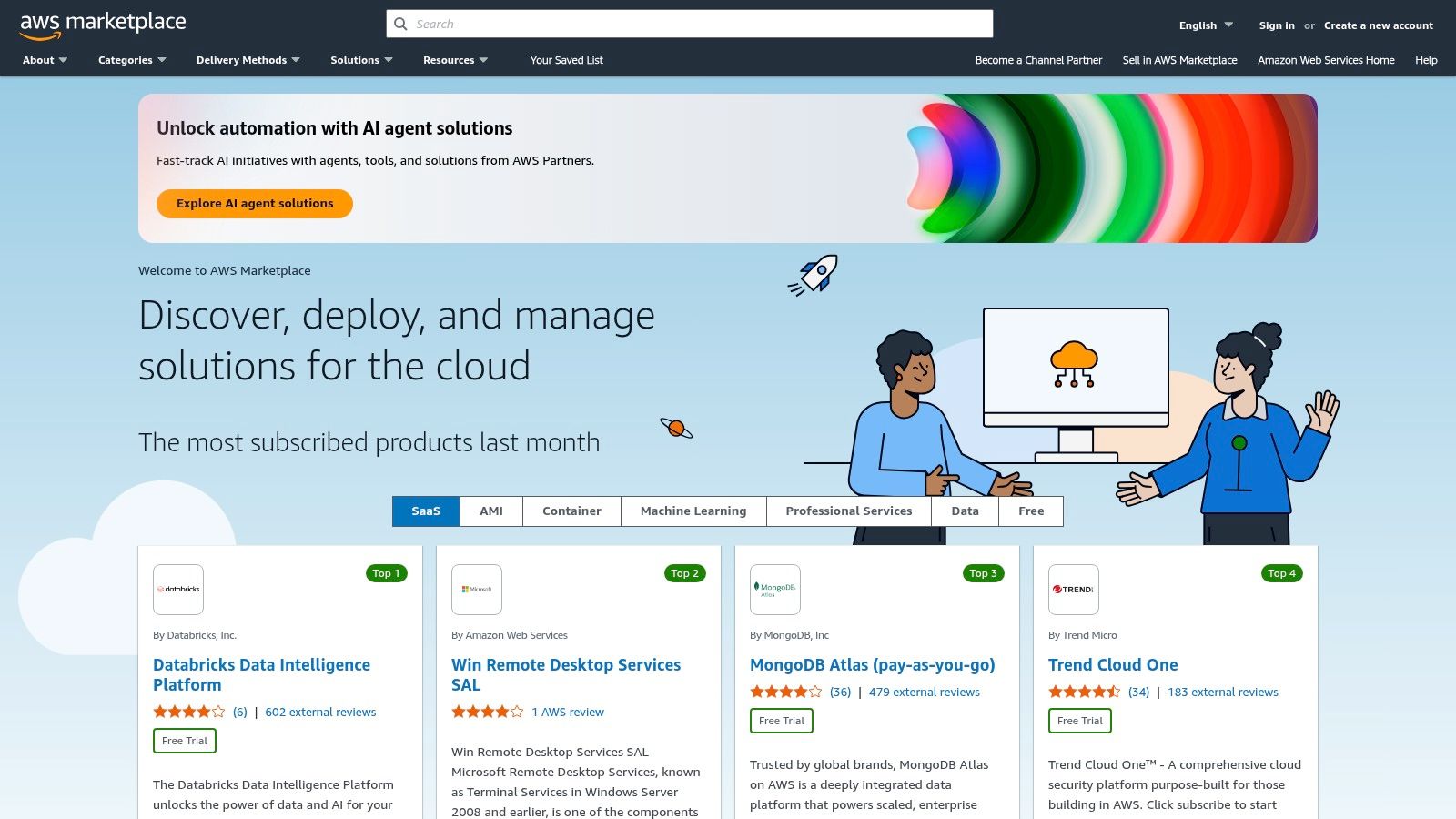
The primary advantage is the simplified procurement and deployment cycle. Legal and healthcare organizations can leverage their existing AWS relationship to access pre-vetted tools that integrate seamlessly with their cloud infrastructure. For example, a hospital system can deploy a HIPAA-eligible automation platform directly from the Marketplace, knowing it meets certain security standards and can be managed within their established AWS environment. This unified approach simplifies vendor management and ensures predictable costs. Explore the game-changing workflow automation benefits to understand how these tools drive success.
Core Features & Use Case
- Integrated Procurement: Purchase and manage software subscriptions directly through your AWS account, simplifying billing and license management across the organization.
- Private Offers & Enterprise Contracts: Allows for customized pricing, terms, and conditions negotiated directly with vendors, which is ideal for large-scale deployments in regulated industries.
- Simplified Deployment: Many listings offer streamlined deployment options, including pre-configured Amazon Machine Images (AMIs) or CloudFormation templates to get started quickly.
Pricing and Access
Pricing models on the AWS Marketplace vary significantly by vendor and can include free trials, hourly/annual subscriptions, or usage-based contracts. Many enterprise-level tools require contacting the vendor for a private offer, which can slow down the initial evaluation process. While AWS provides a layer of trust through its vetting process, some niche workflow automation tools may have limited customer reviews, requiring teams to conduct their own thorough due diligence before committing.
Website: https://aws.amazon.com/marketplace
10. Salesforce AppExchange (Automation collections and apps)
For businesses built on the Salesforce ecosystem, the AppExchange is not just a marketplace; it's an essential extension for finding powerful, pre-vetted workflow automation tools. Rather than a single platform, it’s a curated collection of applications designed to seamlessly integrate with and enhance Salesforce. This makes it an invaluable resource for organizations in regulated industries like legal and healthcare that need to automate processes directly within their core CRM environment, ensuring data integrity and compliance.
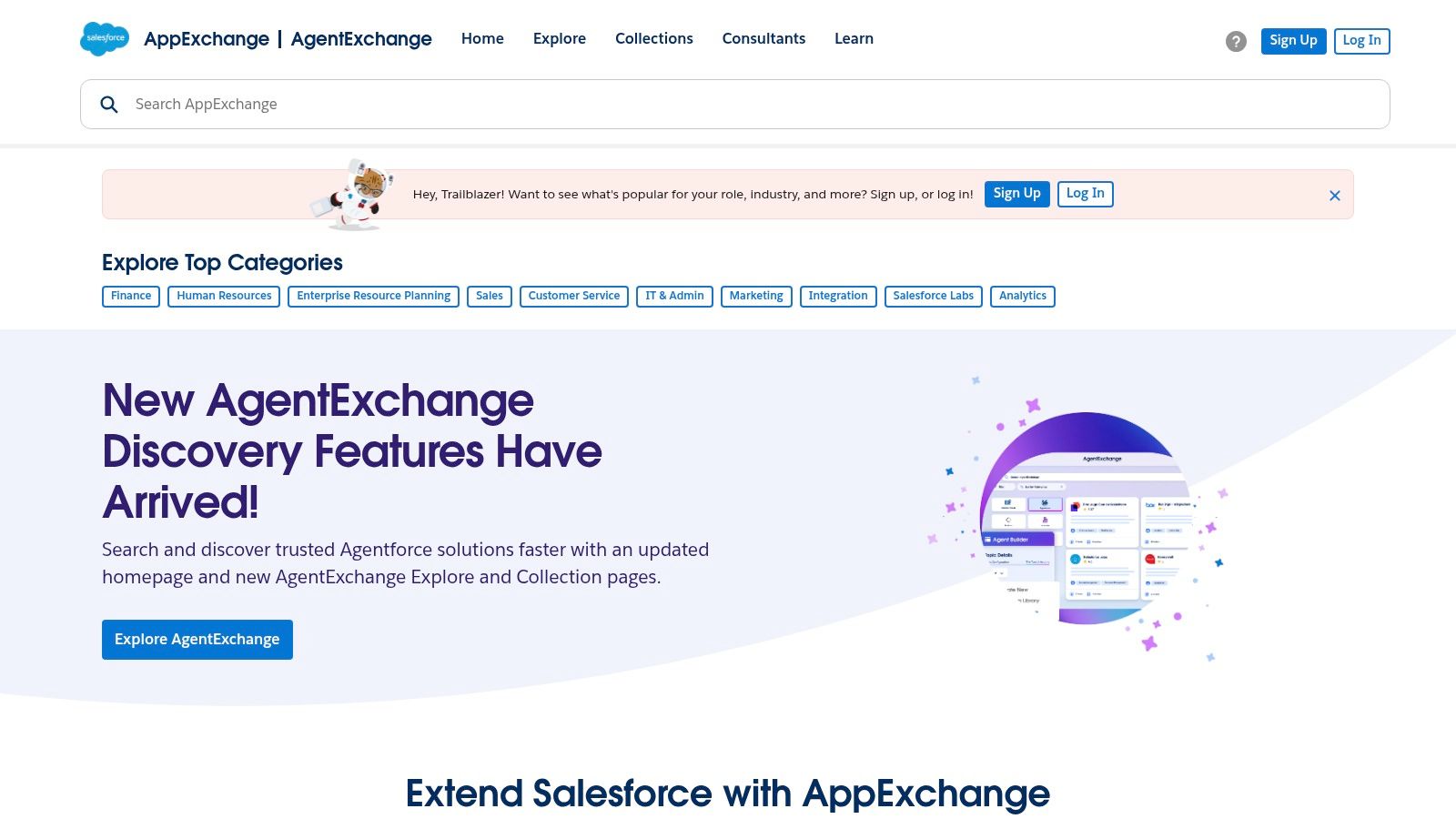
The primary advantage of the AppExchange is its focus on native or deeply integrated solutions. A healthcare provider can find HIPAA-compliant document generation tools that automatically create patient consent forms from Salesforce Health Cloud records. Similarly, a law firm can install an app to automate client intake, matter creation, and time tracking directly from a Salesforce lead or opportunity record, all without complex external connections. Every app undergoes a rigorous security review, providing an extra layer of confidence.
Core Features & Use Case
- Native Salesforce Integration: Apps install directly into your Salesforce org, offering unparalleled access to your data and existing process builders.
- Einstein Automate Collections: Curated bundles of apps and tools designed to solve specific business problems, such as automating lead-to-cash cycles or service case escalations.
- Vetted Enterprise Solutions: Access a wide range of enterprise-grade vendors and specialized vertical solutions, from RPA add-ons to industry-specific connectors.
Pricing and Access
Pricing on the AppExchange is determined by individual app vendors, resulting in a wide spectrum of costs from free to thousands of dollars per month. Each listing typically details its pricing model (per user, per org) and often provides free trials or demos. The main drawback is that these tools are most valuable if your operations are already centered around Salesforce; otherwise, the investment can be difficult to justify.
Website: https://appexchange.salesforce.com
11. G2 (Workflow/Process Automation evaluation)
While not a direct automation tool, G2 is an essential resource for evaluating and selecting the right platform. It serves as a comprehensive B2B software marketplace and review site, offering verified user feedback, detailed comparisons, and data-driven reports on the best workflow automation tools. For professional services firms, G2 provides the social proof and in-depth feature analysis needed to make an informed purchasing decision.
Its core value lies in aggregating real-world user experiences, which is invaluable for understanding how a tool performs in specific industries like legal or healthcare. You can filter reviews based on company size and user role, helping you find feedback from peers facing similar challenges. The platform's Grid Reports and comparison matrices allow you to visually stack up top contenders against each other based on satisfaction ratings and market presence.
Core Features & Use Case
- Verified User Reviews: Access authentic feedback from real users, providing insights into a tool’s strengths, weaknesses, and customer support quality in real-world scenarios.
- Side-by-Side Comparisons: Use detailed feature matrices to directly compare multiple workflow automation tools on specific capabilities, integrations, and security features.
- Category Rankings & Reports: Explore curated "Grid Reports" that rank software based on user satisfaction and market presence, helping to quickly shortlist leading solutions.
Pricing and Access
G2 is completely free for software buyers to use for research and comparison. The platform's business model is based on vendors paying for enhanced profiles, marketing services, and buyer intent data. While this can lead to sponsored placements influencing visibility, the core user review data remains an unbiased and powerful resource for your evaluation process.
Website: https://www.g2.com
12. Capterra (Workflow Automation/Management marketplace)
While not a tool itself, Capterra earns its spot as an indispensable resource for discovering and evaluating the best workflow automation tools on the market. It functions as a comprehensive software directory, providing a bird's-eye view of available platforms with user reviews, feature comparisons, and pricing snapshots. For organizations in regulated industries like legal and healthcare, this initial research phase is critical for identifying vendors that meet specific compliance and operational needs before committing to demos.
Capterra's strength lies in its extensive filtering options and real-world user feedback. A law firm can filter for tools with specific legal case management integrations, while a healthcare provider can search for HIPAA-compliant solutions and read reviews from similar-sized practices. This ability to shortlist potential candidates based on industry-specific criteria and peer experiences saves considerable time and helps avoid costly mismatches. It’s a crucial first step in the procurement process.
Core Features & Use Case
- Category Filtering: Narrow down searches for workflow management tools by features, business size, pricing models, and industry-specific needs.
- User Reviews & Shortlists: Access a large database of verified user reviews and curated reports to gauge platform strengths and weaknesses from actual customers.
- Vendor Profiles: Provides direct links to vendor websites, free trials, and demo requests, centralizing the initial contact process for multiple potential tools.
Pricing and Access
Capterra is a free-to-use resource for buyers. Its business model is based on lead generation fees paid by the software vendors listed on the site. While this makes it accessible, users should be aware that some listings may be prioritized based on sponsorship. It is always recommended to verify pricing and feature details directly with the vendor, as the information on Capterra can sometimes be an aggregated estimate rather than exact figures.
Website: https://www.capterra.com
Top 12 Workflow Automation Tools Comparison
| Platform | Core Features/Capabilities | User Experience & Quality | Value Proposition | Target Audience | Price Points & Notes |
|---|---|---|---|---|---|
| Whisperit 🏆 | AI dictation, transcription, editing ✨ | ★★★★★ Professional-grade | 💰 Contact for pricing | 👥 Legal, healthcare, compliance | Private, secure, Swiss-hosted |
| Zapier | 7,000+ app integrations, AI Agents (beta) | ★★★★ Beginner-friendly | 💰 Flexible pay-as-you-go | 👥 SMBs, teams | Clear free plan & easy upgrades |
| Make | Visual workflow builder, APIs, routers | ★★★★ Power users | 💰 Credits-based pricing | 👥 Advanced users, dev teams | Free tier available |
| Microsoft Power Automate | RPA, 600+ connectors, process mining | ★★★★ Enterprise-grade | 💰 Pay-as-you-go | 👥 Microsoft ecosystem users | Complex licensing |
| n8n | Open-source, self-hosting, 220+ nodes | ★★★★ Developer-centric | 💰 Cost-effective at scale | 👥 Technical teams | Usage-based billing |
| Workato | Enterprise security, role mgmt, training | ★★★★★ Enterprise ready | 💰 Quote-based pricing | 👥 Large enterprises | Higher cost |
| IFTTT | Simple applets, IoT workflows | ★★★ Casual/simple use | 💰 Low cost | 👥 Consumers, light business | Freemium with paid tiers |
| Tray.io | Visual builder, custom connectors, security | ★★★★ Advanced enterprise | 💰 Quote-based pricing | 👥 RevOps, IT teams | Not public pricing |
| AWS Marketplace | SaaS procurement, consolidated billing | ★★★ Enterprise procurement | 💰 Vendor dependent | 👥 AWS users, enterprises | Vendor pricing varies |
| Salesforce AppExchange | Native automation apps, Salesforce integration | ★★★★ Salesforce ecosystem | 💰 Varies by app | 👥 Salesforce customers | Wide pricing range |
| G2 | User reviews & comparison platform | ★★★★ Broad insight | 🆓 Free user resource | 👥 All buyers | Free |
| Capterra | Software directory, pricing and reviews | ★★★★ Wide coverage | 🆓 Free user resource | 👥 Buyers across sizes | Free |
Making Your Choice: How to Select the Right Automation Tool for Your Team
Navigating the landscape of the best workflow automation tools can feel overwhelming, but the journey from evaluation to implementation is a strategic one. As we've explored, the market offers a diverse range of solutions, from broad-spectrum iPaaS connectors like Zapier and Make to enterprise-grade powerhouses like Workato and deeply integrated ecosystem players like Microsoft Power Automate. Your final decision shouldn't be based on which tool has the longest feature list, but on which one aligns most precisely with your organization's unique operational DNA, security posture, and strategic goals.
The central takeaway is this: there is no single "best" platform for everyone. The ideal tool is the one that solves your most pressing problems with the least amount of friction. For a marketing team needing to connect dozens of cloud apps for simple "if this, then that" tasks, Zapier offers unmatched simplicity and a vast connector library. For a development team seeking granular control and the ability to host their own automation engine, a self-hosted solution like n8n provides unparalleled flexibility and cost-effectiveness.
A Framework for Your Final Decision
To distill this comprehensive list into a practical choice, it’s crucial to move beyond feature-for-feature comparisons and instead focus on your core requirements. Your selection process should be an internal audit of your needs, resources, and priorities. Begin by asking the right questions and mapping your answers to the tools we've discussed.
Here’s a structured approach to guide your final evaluation:
- Define Your Primary Use Case: Is your main goal to automate a specific, high-stakes business process, or is it to create a wide net of simple connections between disparate cloud services? If you are a legal firm generating sensitive client contracts or a healthcare provider processing patient intake forms, a specialized tool like Whisperit is designed for your exact workflow, offering security and compliance features that general-purpose tools cannot replicate. In contrast, if your goal is broad-based connectivity across marketing, sales, and HR apps, an iPaaS solution is a more logical starting point.
- Assess Your Technical Capacity: Be realistic about the technical expertise available on your team. No-code platforms like Zapier and IFTTT are built for business users and require no programming knowledge, enabling rapid deployment. Low-code platforms such as Make and Tray.io offer greater power and complexity but assume a degree of technical comfort with concepts like APIs and data mapping. Tools like n8n and Workato often require dedicated developer or IT involvement to maximize their potential.
- Evaluate Security and Compliance Needs: For industries like legal, healthcare, and finance, this is non-negotiable. Scrutinize a platform's security credentials. Do they hold SOC 2 Type 2, HIPAA, or GDPR compliance certifications? Where is your data stored and how is it encrypted? General-purpose automation tools may connect to secure apps, but they often act as a "middle-man," creating an additional point of potential vulnerability. For workflows handling Protected Health Information (PHI) or confidential client data, a platform built with a security-first architecture is essential.
- Consider Total Cost of Ownership (TCO): Look beyond the monthly subscription fee. Factor in the cost of implementation, training, and developer time if required. A seemingly cheaper tool that requires significant IT resources to manage can quickly become more expensive than a premium, user-friendly platform that empowers your entire team to build their own automations. Consider the pricing model: is it based on tasks, users, or connections? Choose a model that aligns with your anticipated usage to avoid unexpected costs as you scale.
By systematically working through these four pillars, you can confidently narrow down the list of the best workflow automation tools to a shortlist of two or three top contenders. From there, the path forward is clear: sign up for free trials, build a proof-of-concept for a single, high-value workflow, and measure the impact. The right tool will quickly prove its worth, not just in hours saved, but in its ability to unlock new efficiencies and empower your team to focus on what truly matters.
Ready to automate your most critical document workflows with uncompromising security? Whisperit is purpose-built for professionals in legal and healthcare who demand precision, compliance, and ease of use. Discover how our secure, specialized platform can transform your operations by visiting Whisperit to schedule a personalized demo today.